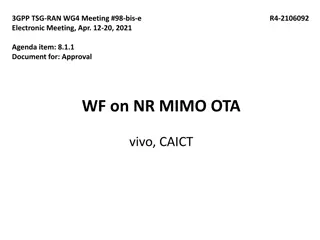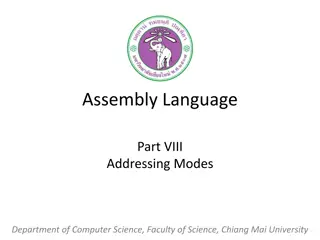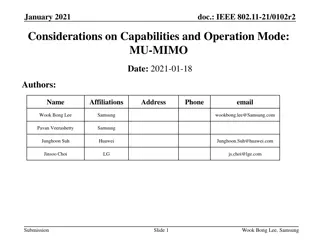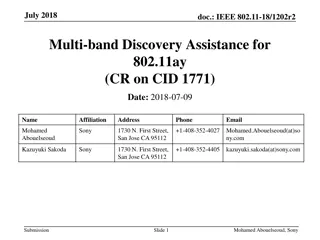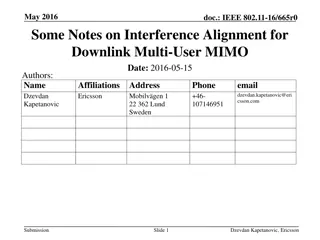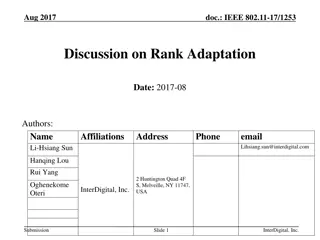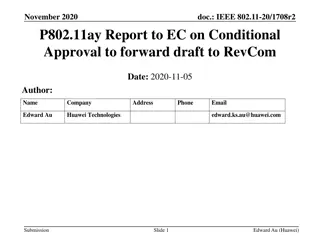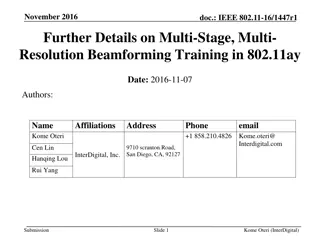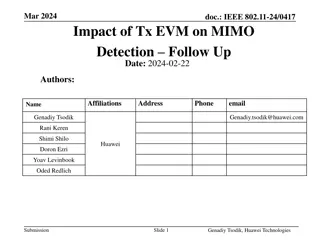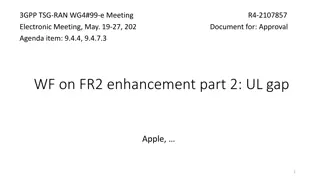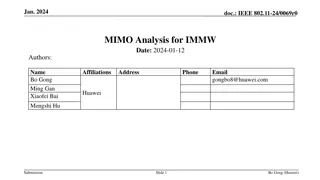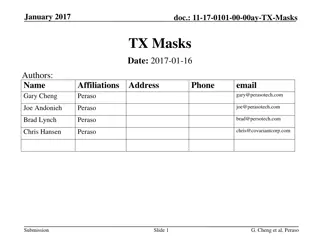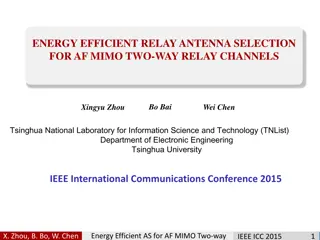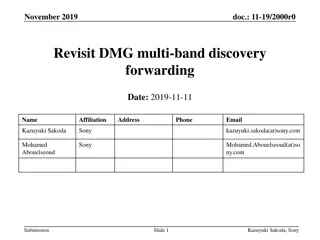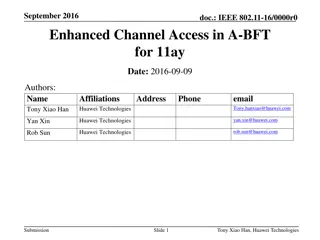Performance Analysis of Robust Transmission Modes for MIMO in 11ay
This presentation by Intel Corporation discusses the performance analysis of robust transmission modes for MIMO using MRC 1x2, Alamouti 2x1, and Alamouti 2x2 schemes in IEEE 802.11-16/0632r1. It evaluates the performance of OFDM and SC signal structures in frequency flat and frequency selective Rayleigh channels, comparing different modulations such as SQPSK, QPSK, BPSK, and more.
Download Presentation

Please find below an Image/Link to download the presentation.
The content on the website is provided AS IS for your information and personal use only. It may not be sold, licensed, or shared on other websites without obtaining consent from the author. Download presentation by click this link. If you encounter any issues during the download, it is possible that the publisher has removed the file from their server.
E N D
Presentation Transcript
May 2016 doc.: IEEE 802.11-16/0632r1 Performance Analysis of Robust Transmission Modes for MIMO in 11ay Date: 2016-16-05 Authors: Name Affiliations Address Phone email +7 (831) 2969444 Turgeneva 30, Nizhny Novgorod, 603024, Russia artyom.lomayev@intel.com Artyom Lomayev Intel alexander.maltsev@intel.com Alexander Maltsev Intel yaroslav.p.gagiev@intel.com Yaroslav Gagiev Intel miki.genossar@intel.com Miki Genossar Intel assaf.kasher@intel.com Assaf Kasher Intel carlos.cordeiro@intel.com Carlos Cordeiro Intel Submission Slide 1 Intel Corporation
May 2016 doc.: IEEE 802.11-16/0632r1 Introduction This presentation describes the results of performance analysis for MIMO robust transmission modes using MRC 1x2, Alamouti 2x1 and Alamouti 2x2 schemes. OFDM and SC signal structure is proposed to support Alamouti signal processing, [1], [2]. The performance of OFDM and SC PHY is evaluated in frequency flat and frequency selective Rayleigh channel. In case of OFDM PHY the performance of dual carrier SQPSK and QPSK modulations and regular BPSK and QPSK modulations providing the same data rate is compared. Submission Slide 2 Intel Corporation
May 2016 doc.: IEEE 802.11-16/0632r1 Considered System Configurations MRC 1x2 RX antenna #1 Configurations: MRC 1x2: 1 TX and 2 RX antennas; Alamouti 2x1: 2 TX and 1 RX antenna; Alamouti 2x2: 2 TX and 2 RX antennas; Usage cases: STA -> AP MRC 1x2, AP -> STA Alamouti 2x1; STA -> AP, AP -> STA, Alamouti 2x2; H1 Combiner TX antenna #0 H0 RX antenna #0 Alamouti 2x2 Alamouti 2x1 TX antenna #1 RX antenna #1 TX antenna #1 RX antenna #0 H3 H1 Combiner Combiner H2 H1 H0 H0 TX antenna #0 RX antenna #0 TX antenna #0 Submission Slide 3 Intel Corporation
May 2016 doc.: IEEE 802.11-16/0632r1 OFDM Subcarriers Mapping For the regular modulation, the input pair of symbols (Xk, Yk) is mapped to the k-th subcarrier for OFDM symbol #1 for spatial streams 1 and 2 (TX antennas #0 and #1). The input pair is repeated with complex conjugation and sign inversion for Yk as (-Yk*, Xk*) and mapped to the k-th subcarrier for OFDM symbol #2 for spatial streams 1 and 2 (TX antennas #0 and #1). Spatial stream #1 symbol #1 Xk Spatial stream #1 symbol #2 -Yk * Antenna #0 Spatial stream #2 symbol #1 Yk Spatial stream #2 symbol #2 Xk * Antenna #1 Submission Slide 4 Intel Corporation
May 2016 doc.: IEEE 802.11-16/0632r1 OFDM Subcarriers Mapping for DCM In case of the DCM SQPSK and QPSK modulations the subcarriers mapping is shown below. (X0,X1) and (Y0,Y1) represent the pairs of DCM symbols. In the simulations STP mapping was used only. SQPSK/QPSK (X0, X1) Symbols repetition Spatial stream #1 symbol #1 X0 Spatial stream #1 symbol #2 -Y0 * * X1 -Y1 Antenna #0 Data Data Data Data subcarrier P(k) subcarrier k subcarrier P(k) subcarrier k Spatial stream #2 symbol #1 Y0 Spatial stream #2 symbol #2 X0 * * X1 Y1 Antenna #1 Data Data Data Data subcarrier k subcarrier k subcarrier P(k) subcarrier P(k) Submission Slide 5 Intel Corporation SQPSK/QPSK (Y0, Y1)
May 2016 doc.: IEEE 802.11-16/0632r1 SC Frame Format Definitions Definitions: Guard Interval (GI) sequences: GI sequence: GIM(n) = [a1, a2, , aM-1, aM]; GI sequence with time inversion and complex conjugation: GIM*(-n) = [aM*, aM-1*, , a2*, a1*]; GI sequence with time inversion, complex conjugation and sign inversion: -GIM*(-n) = [-aM*, -aM-1*, , -a2*, -a1*]; Data sequence for SC symbol: sN(n) = [s1, s2, , sN-1, sN]; Time inversion and complex conjugation of the SC symbol: sN*(-n) = [sN*, sN-1*, , s2*, s1*]; Submission Slide 6 Intel Corporation
May 2016 doc.: IEEE 802.11-16/0632r1 SC Frame Format (Cont d) Spatial stream #1 symbol #1 Xk Spatial stream #1 symbol #2 -Yk * DFT DFT DFT interval DFT interval 1st stream *(-n) *(-n) *(-n) *(-n) GIM(n) GIM xN-2M(n) GIM(n) -GIM -yN-2M GIM(n) GIM . . . 2nd stream *(-n) *(-n) *(-n) *(-n) GIM(n) -GIM yN-2M(n) GIM(n) GIM xN-2M GIM(n) -GIM . . . DFT DFT Spatial stream #2 symbol #2 Xk Spatial stream #2 symbol #1 Yk * Submission Slide 7 Intel Corporation
May 2016 doc.: IEEE 802.11-16/0632r1 SC Frame Format (Cont d) GI property: GI is not changed after application of time inversion and complex conjugation operation. DFT interval *(-n) GIM(n) GIM xN-2M(n) GIM(n) Time reverse and conjugation Operation saves GI at the end *(-n) *(-n) GIM xN-2M GIM(n) In simulations GI size M = 32, DFT size N = 512, data part size N-2*M = 448. The GI size can be increased, there is a trade-off between data size and GI size. Submission Slide 8 Intel Corporation
May 2016 doc.: IEEE 802.11-16/0632r1 Simulated Channel Models LOS channel model: MRC 1x2, Alamouti 2x1 only; H0 and H1 have unit power, uniformly distributed random phase; NLOS Rayleigh channel model: MRC 1x2, Alamouti 2x1, Alamouti 2x2; H0, H1, H2, H3 are independent channels, have exponential delay profile in time domain, 3 ns RMS delay spread, amplitudes are Rayleigh distributed variables; Submission Slide 9 Intel Corporation
May 2016 doc.: IEEE 802.11-16/0632r1 Simulation Assumptions PPDU length 8192 bytes; LDPC uses LBP with min-sum approximation, maximum number of iterations per CW is 20; Number of simulated frames per SNR point is 105; Ideal channel knowledge, ideal acquisition, no RF imperfections; OFDM: SISO ZF receiver; SC: SISO LMMSE receiver; Submission Slide 10 Intel Corporation
May 2016 doc.: IEEE 802.11-16/0632r1 LOS Simulation Results MRC 1x2 in LOS channel provides 3.0 dB SNR enhancement; Corresponding data rate increment due to application of MRC depends on SNR and can be 0.7 1.7 Gbps; MRC 1x2 vs. SISO Submission Slide 11 Intel Corporation
May 2016 doc.: IEEE 802.11-16/0632r1 NLOS Simulation Results MRC 1x2 in NLOS independent Rayleigh channel provides 4.1 8.3 dB SNR enhancement; Corresponding data rate increment due to application of MRC depends on SNR and can be 0.8 3.7 Gbps; MRC 1x2 vs. SISO Submission Slide 12 Intel Corporation
May 2016 doc.: IEEE 802.11-16/0632r1 NLOS Simulation Results (Cont d) Alamouti 2x1 scheme exhibits the same gain as MRC 1x2 if it has the same transmit power per antenna. Alamouti 2x2 scheme provides further enhancement in SNR of 0.6 2.5 dB or data rate enhancement of 0.1 1.2 Gbps. Alamouti 2x2 vs. Alamouti 2x1 Submission Slide 13 Intel Corporation
May 2016 doc.: IEEE 802.11-16/0632r1 NLOS Simulation Results (Cont d) DCM SQPSK/QPSK modulations additional gain in SNR for PER = 10-2 over the regular BPSK/QPSK modulations in NLOS Rayleigh channel: MCS SISO MRC 1x2 (Alamouti 2x1) Alamouti 2x2 13 1.8 dB 0.9 dB 0.3 dB 14 2.3 dB 1.0 dB 0.5 dB 15 0.7 dB 0.1 dB 0.1 dB 16 1.3 dB 0.4 dB 0.1 dB 17 2.0 dB 0.8 dB 0.3 dB Submission Slide 14 Intel Corporation
May 2016 doc.: IEEE 802.11-16/0632r1 Conclusions This presentation describes performance analysis of the robust MIMO transmission modes including MRC 1x2, Alamouti 2x1 and Alamouti 2x2 schemes. It was demonstrated that in frequency flat LOS channel one can achieve 3.0 dB SNR gain applying MRC 1x2 or Alamouti 2x1 schemes. In NLOS frequency selective channels the SNR gain can be very significant of 4.1 8.3 dB for MRC 1x2 and Alamouti 2x1 schemes. Further SNR enhancement is possible applying Alamouti 2x2 scheme by 0.6 2.5 dB. OFDM and SC modulations with diversity schemes exhibit similar performance in frequency flat and selective channels. In case of OFDM application of DCM modulations in combination with Alamouti technique provides additional SNR gain of 1.0 dB. The considered diversity schemes are proposed to be used in the 11ay standard for robust data transmission modes. Submission Slide 15 Intel Corporation
May 2016 doc.: IEEE 802.11-16/0632r1 Straw Poll Would you agree to insert the following in section 7 of the SFD: The 11ay specification shall enable transmit diversity schemes including Alamouti scheme for both SC and OFDM modulations for MIMO data transmission. Submission Slide 16 Intel Corporation
May 2016 doc.: IEEE 802.11-16/0632r1 References 1. Siavash M. Alamouti, A Simple Transmit Diversity Technique for Wireless Communications, IEEE Journal on Selected Areas in Communications, vol. 16, no. 8, October 1998. Submission Slide 17 Intel Corporation





